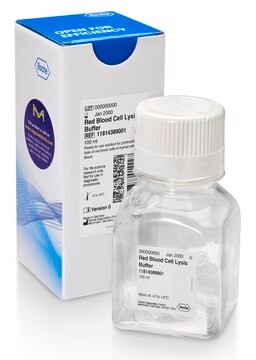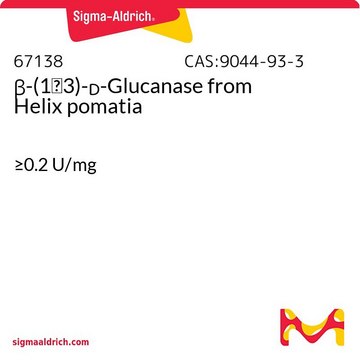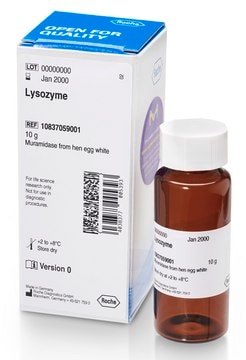17-10050
ChIPAb+ Acetyl-Histone H3 (Lys4) - ChIP Validated Antibody and Primer Set
from rabbit, purified by affinity chromatography
Sinônimo(s):
H3K4Ac, Histone H3 (acetyl K4), H3 histone family, member T, histone 3, H3, histone cluster 3, H3
Faça loginpara ver os preços organizacionais e de contrato
About This Item
Código UNSPSC:
12352203
eCl@ss:
32160702
NACRES:
NA.52
Produtos recomendados
fonte biológica
rabbit
Nível de qualidade
clone
polyclonal
purificado por
affinity chromatography
reatividade de espécies
human
fabricante/nome comercial
ChIPAb+
Upstate®
técnica(s)
ChIP: suitable
immunoprecipitation (IP): suitable
western blot: suitable
nº de adesão NCBI
nº de adesão UniProt
Condições de expedição
dry ice
Categorias relacionadas
Descrição geral
All ChIPAb+ antibodies are individually validated for chromatin precipitation, every lot, every time. Each ChIPAb+ antibody set includes control primers (tested every lot by qPCR) to biologically validate your IP results in a locus-specific context. The qPCR protocol and primer sequences are provided, allowing researchers to validate ChIP protocols when using our antibody in their chromatin context. Each set also includes a negative control antibody to ensure specificity of the ChIP reaction.
The ChIPAb+ Acetyl-Histone H3 (Lys4) set includes the Acetyl-Histone H3 (Lys4) antibody, a negative control antibody (normal rabbit IgG), and qPCR primers which amplify a 166 bp region of human GAPDH. The Acetyl-Histone H3 (Lys4) and negative controls are supplied in a scalable "per ChIP" reaction size and can be used to functionally validate the precipitation of Acetyl-Histone H3 (Lys4)-associated chromatin.
The ChIPAb+ Acetyl-Histone H3 (Lys4) set includes the Acetyl-Histone H3 (Lys4) antibody, a negative control antibody (normal rabbit IgG), and qPCR primers which amplify a 166 bp region of human GAPDH. The Acetyl-Histone H3 (Lys4) and negative controls are supplied in a scalable "per ChIP" reaction size and can be used to functionally validate the precipitation of Acetyl-Histone H3 (Lys4)-associated chromatin.
Histone H3 is one of the five main histone proteins involved in the structure of chromatin in eukaryotic cells. Featuring a main globular domain and a long N-terminal tail, H3 is involved with the structure of the nucleosomes of the ′beads on a string′ structure. Histone proteins are highly post-translationally modified, and Histone H3 is the most extensively modified of the five histones. The term "Histone H3" alone is purposely ambiguous in that it does not distinguish between sequence variants or modification state. Histone H3 is an important protein in the emerging field of epigenetics, where its sequence variants and variable modification states are thought to play a role in the dynamic and long term regulation of genes.
Especificidade
Recognizes Histone H3 acetylated on Lys4.
Wide range of cross-reactivity expected based on sequence homology.
Imunogênio
Epitope: Acetylated Lys4
KLH-conjugated, synthetic peptide containing the sequence …RTAcKQ… in which AcK corresponds to acetyl lysine 4 of human histone H3.
Aplicação
Chromatin Immunoprecipitation:
Sonicated chromatin prepared from HeLa cells (1 X 106 cell equivalents per IP) were subjected to chromatin immunoprecipitation using 4 µL of Normal rabbit IgG or 4 µL Anti-Acetyl-Histone H3 (Lys4) and the Magna ChIP® A Kit (Cat. # 17-610).
Successful immunoprecipitation of Acetyl-Histone H3 (Lys4) associated DNA fragments was verified by qPCR using Control Primers as a positive locus on the GAPDH promoter, and β-Globin primers as a negative locus. (Please see figures).
Data is presented as percent input of each IP sample relative to input chromatin for each amplicon and ChIP sample as indicated.
Please refer to the EZ-Magna ChIP A (Cat. # 17-408) or EZ-ChIP (Cat. # 17-371) protocol for experimental details.
Western Blot Analysis:
Representative lot data.
Recombinant histone H3 (Catalog # 14-411, lane 1) and acid extracts from sodium butyrate treated (lane 2) and untreated (lane 3) HeLa cells (Catalog # 17-305) were resolved by electrophoresis, transferred to nitrocellulose and probed with anti-acetyl-Histone H3 (Lys4) (1:1,000 dilution).
Proteins were visualized using a goat anti-rabbit secondary antibody conjugated to HRP and a chemiluminescence detection system. (Please see pictures).
Histone-Peptide Specificity Assay: Representative lot data.
A 1:1,000 – 1:5,000 dilution of anti-acetyl Histone H3 (Lys4) was incubated with a cocktail of microspheres conjugated to histone H3
peptides with the following modifications:
1. Unmodified, containing Lys 4, 9, 14 and 18
2. Acetyl-lysine 4
3. Acetyl-lysine 9
4. Acetyl-lysine 14
5. Acetyl-lysine 18
6. Acetyl-lysine 23
7. Acetyl-lysine 27
Unbound antibody was then removed by filtration. Peptide-antibody complexes were incubated with a biotin-conjugated anti-rabbit secondary antibody followed by incubation with a phycoerythrin-streptavidin conjugate. Fluorescence was read on a Luminex 100 instrument.
Median Fluorescence Intensity (MFI) is plotted (Please see figures).
Sonicated chromatin prepared from HeLa cells (1 X 106 cell equivalents per IP) were subjected to chromatin immunoprecipitation using 4 µL of Normal rabbit IgG or 4 µL Anti-Acetyl-Histone H3 (Lys4) and the Magna ChIP® A Kit (Cat. # 17-610).
Successful immunoprecipitation of Acetyl-Histone H3 (Lys4) associated DNA fragments was verified by qPCR using Control Primers as a positive locus on the GAPDH promoter, and β-Globin primers as a negative locus. (Please see figures).
Data is presented as percent input of each IP sample relative to input chromatin for each amplicon and ChIP sample as indicated.
Please refer to the EZ-Magna ChIP A (Cat. # 17-408) or EZ-ChIP (Cat. # 17-371) protocol for experimental details.
Western Blot Analysis:
Representative lot data.
Recombinant histone H3 (Catalog # 14-411, lane 1) and acid extracts from sodium butyrate treated (lane 2) and untreated (lane 3) HeLa cells (Catalog # 17-305) were resolved by electrophoresis, transferred to nitrocellulose and probed with anti-acetyl-Histone H3 (Lys4) (1:1,000 dilution).
Proteins were visualized using a goat anti-rabbit secondary antibody conjugated to HRP and a chemiluminescence detection system. (Please see pictures).
Histone-Peptide Specificity Assay: Representative lot data.
A 1:1,000 – 1:5,000 dilution of anti-acetyl Histone H3 (Lys4) was incubated with a cocktail of microspheres conjugated to histone H3
peptides with the following modifications:
1. Unmodified, containing Lys 4, 9, 14 and 18
2. Acetyl-lysine 4
3. Acetyl-lysine 9
4. Acetyl-lysine 14
5. Acetyl-lysine 18
6. Acetyl-lysine 23
7. Acetyl-lysine 27
Unbound antibody was then removed by filtration. Peptide-antibody complexes were incubated with a biotin-conjugated anti-rabbit secondary antibody followed by incubation with a phycoerythrin-streptavidin conjugate. Fluorescence was read on a Luminex 100 instrument.
Median Fluorescence Intensity (MFI) is plotted (Please see figures).
Research Category
Epigenetics & Nuclear Function
Epigenetics & Nuclear Function
Research Sub Category
Histones
Histones
This ChIPAb+ Acetyl-Histone H3 (Lys4) -ChIP Validated Antibody & Primer Set conveniently includes the antibody & the specific control PCR primers.
Embalagem
25 assays per set. Recommended use: ~4 μL of antibody per chromatin immunoprecipitation (dependent upon biological context).
Componentes
Anti-Acetyl-Histone H3 (Lys4) (rabbit polyclonal)
Normal Rabbit IgG
Control Primers
Normal Rabbit IgG
Control Primers
Qualidade
Chromatin Immunoprecipitation:
Sonicated chromatin prepared from HeLa cells (1 X 106 cell equivalents per IP) were subjected to chromatin immunoprecipitation using 4 µL of Normal Rabbit IgG or 4 µL Anti-Acetyl-Histone H3 (Lys4) and the Magna ChIP® A Kit (Cat. # 17-610). Successful immunoprecipitation of Acetyl-Histone H3 (Lys4) associated DNA fragments was verified by qPCR using Control Primers (Please see figures).
Please refer to the EZ-Magna ChIP A (Cat. # 17-408) or EZ-ChIP (Cat. # 17-371) protocol for experimental details.
Sonicated chromatin prepared from HeLa cells (1 X 106 cell equivalents per IP) were subjected to chromatin immunoprecipitation using 4 µL of Normal Rabbit IgG or 4 µL Anti-Acetyl-Histone H3 (Lys4) and the Magna ChIP® A Kit (Cat. # 17-610). Successful immunoprecipitation of Acetyl-Histone H3 (Lys4) associated DNA fragments was verified by qPCR using Control Primers (Please see figures).
Please refer to the EZ-Magna ChIP A (Cat. # 17-408) or EZ-ChIP (Cat. # 17-371) protocol for experimental details.
Descrição-alvo
~17 kDa
forma física
Affinity purified
Anti-Acetyl-Histone H3 (Lys4) (rabbit polyclonal). One vial containing 100 µL of immunoaffinity purified rabbit polyclonal in storage buffer containing 0.05% sodium azide with 30% glycerol. Store at -20°C.
Normal Rabbit IgG. One vial containing 125 µg Rabbit IgG in 125 µL storage buffer containing 0.05% sodium azide. Store at -20°C.
Control Primers. One vial containing 75 μL of 5 μM each primer specific for human GAPDH. Store at -20°C.
FOR: TAC TAG CGG TTT TAC GGG CG
REV: TCG AAC AGG AGG AGC AGA GAG CGA
Normal Rabbit IgG. One vial containing 125 µg Rabbit IgG in 125 µL storage buffer containing 0.05% sodium azide. Store at -20°C.
Control Primers. One vial containing 75 μL of 5 μM each primer specific for human GAPDH. Store at -20°C.
FOR: TAC TAG CGG TTT TAC GGG CG
REV: TCG AAC AGG AGG AGC AGA GAG CGA
Armazenamento e estabilidade
Stable for 1 year at -20°C from date of receipt. Handling Recommendations: Upon first thaw, and prior to removing the cap, centrifuge the vial and gently mix the solution. Aliquot into microcentrifuge tubes and store at -20°C. Avoid repeated freeze/thaw cycles, which may damage IgG and affect product performance. Note: Variability in freezer temperatures below -20°C may cause glycerol containing solutions to become frozen during storage.
Nota de análise
Control
Includes negative control antibody and primers specific for human GAPDH.
Includes negative control antibody and primers specific for human GAPDH.
Informações legais
MAGNA CHIP is a registered trademark of Merck KGaA, Darmstadt, Germany
UPSTATE is a registered trademark of Merck KGaA, Darmstadt, Germany
Exoneração de responsabilidade
Unless otherwise stated in our catalog or other company documentation accompanying the product(s), our products are intended for research use only and are not to be used for any other purpose, which includes but is not limited to, unauthorized commercial uses, in vitro diagnostic uses, ex vivo or in vivo therapeutic uses or any type of consumption or application to humans or animals.
Código de classe de armazenamento
10 - Combustible liquids
Certificados de análise (COA)
Busque Certificados de análise (COA) digitando o Número do Lote do produto. Os números de lote e remessa podem ser encontrados no rótulo de um produto após a palavra “Lot” ou “Batch”.
Já possui este produto?
Encontre a documentação dos produtos que você adquiriu recentemente na biblioteca de documentos.
Emily R Albright et al.
Journal of virology, 87(17), 9802-9812 (2013-07-05)
Human cytomegalovirus (HCMV) is a significant human pathogen that achieves lifelong persistence by establishing latent infections in undifferentiated cells of the myeloid lineage, such as CD34(+) hematopoietic progenitor cells. When latency is established, viral lytic gene expression is silenced in
Nossa equipe de cientistas tem experiência em todas as áreas de pesquisa, incluindo Life Sciences, ciência de materiais, síntese química, cromatografia, química analítica e muitas outras.
Entre em contato com a assistência técnica







